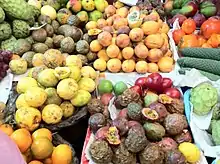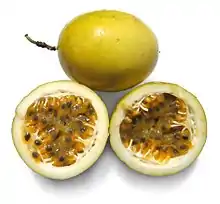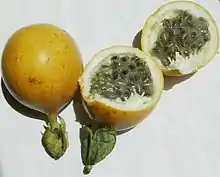Passion fruit (fruit)
The passion fruit is the fruit of a number of plants in the genus Passiflora.[1][2]

Etymology
The passion fruit is so called because it is one of the many species of passion flower, the English translation of the Latin genus name, Passiflora, and may be spelled "passion fruit", "passionfruit", or "passion-fruit".[1][3] Around 1700, the name was given by missionaries in Brazil as an educational aid while trying to convert the indigenous inhabitants to Christianity; its name was flor das cinco chagas or "flower of the five wounds" to illustrate the crucifixion of Christ and his resurrection,[4] with other plant components also named after an emblem in the Passion of Jesus.[3]
Appearance and structure
Passion fruits are round or oval.[1] They can be yellow, red, purple, and green.[1] The fruits have a juicy edible center composed of a large number of seeds.[1]
Varieties
Edible passion fruits can be divided into four main types:
- purple passion fruit (fruits of Passiflora edulis Sims),
- yellow passion fruit (Passiflora edulis f. flavicarpa Deg.),
- sweet granadilla (Passiflora ligularis),
- giant granadilla (Passiflora quadrangularis L.).[5]
Uses
The part of the fruit that is used (eaten) is the pulpy juicy seeds. Passion fruits can also be squeezed to make juice.[1]
Nutrition
| Nutritional value per 100 g (3.5 oz) | |
|---|---|
| Energy | 406 kJ (97 kcal) |
22.4 g | |
| Sugars | 11.2 g |
| Dietary fiber | 10.4 g |
0.7 g | |
2.2 g | |
| Vitamins | Quantity %DV† |
| Vitamin A equiv. | 8% 64 μg7% 743 μg |
| Riboflavin (B2) | 11% 0.13 mg |
| Niacin (B3) | 10% 1.5 mg |
| Vitamin B6 | 8% 0.1 mg |
| Folate (B9) | 4% 14 μg |
| Choline | 2% 7.6 mg |
| Vitamin C | 36% 30 mg |
| Vitamin K | 1% 0.7 μg |
| Minerals | Quantity %DV† |
| Calcium | 1% 12 mg |
| Iron | 12% 1.6 mg |
| Magnesium | 8% 29 mg |
| Phosphorus | 10% 68 mg |
| Potassium | 7% 348 mg |
| Sodium | 2% 28 mg |
| Zinc | 1% 0.1 mg |
| Other constituents | Quantity |
| Water | 72.9 g |
| |
| †Percentages are roughly approximated using US recommendations for adults. Source: USDA FoodData Central | |
Raw passion fruit is 73% water, 22% carbohydrates, 2% protein and 0.7% fat (table). In a 100 gram amount, fresh passion fruit supplies 97 calories, and contains 36% of the Daily Value (DV) of vitamin C, 42% dietary fiber, B vitamins riboflavin (11% DV) and niacin (10% DV), 12% iron and 10% phosphorus (table).[6] No other micronutrients are in significant content.
Phytochemicals
Several varieties of passionfruit are rich in polyphenol content,[7][8] and yellow [Note 1] varieties of the fruit were found to contain prunasin and other cyanogenic glycosides in the peel and juice.[9]
Gallery
 Purple passionfruit (Passiflora edulis)
Purple passionfruit (Passiflora edulis) Yellow passionfruit (Passiflora edulis f. flavicarpa)
Yellow passionfruit (Passiflora edulis f. flavicarpa).jpg.webp) Passiflora ligularis in flower
Passiflora ligularis in flower Passiflora ligularis fruit
Passiflora ligularis fruit Red, yellow, and green Passiflora edulis
Red, yellow, and green Passiflora edulis Giant granadilla (Passiflora quadrangularis L.)
Giant granadilla (Passiflora quadrangularis L.) Passion fruit flower
Passion fruit flower Unripe common passion fruit
Unripe common passion fruit
See also
Notes
- Specific mention of P. edulis f. flavicarpa juice and peel[9]
References
- Morton JF (1987). "Passionfruit, p. 320–328; In: Fruits of Warm Climates". NewCrop, Center for New Crops and Plant Products, Department of Horticulture and Landscape Architecture at Purdue University, W. Lafayette, Indiana. Retrieved 22 January 2020.
- Dennis S. Hill (16 July 2008). Pests of Crops in Warmer Climates and Their Control. Springer Science & Business Media. pp. 605–. ISBN 978-1-4020-6738-9.
- Davidson, Alan (2014). Passion-fruit; In: The Oxford Companion to Food (page 597; Ed. 3). Oxford University Press, Oxford, UK. ISBN 978-0191040726.
- "Origin of the Name Passionfruit".
- Experts from Dole Food Company; Experts from The Mayo Clinic; Experts from UCLA Center for H (13 January 2002). Encyclopedia of Foods: A Guide to Healthy Nutrition. Elsevier. pp. 195–. ISBN 978-0-08-053087-1.
- "Nutrition facts for Passion-fruit, (granadilla), purple, raw, 100 g". USDA Nutrient Data, SR-21. Conde Nast. Retrieved April 2, 2013.
- Talcott ST, Percival SS, Pittet-Moore J, Celoria C (2003). "Phytochemical composition and antioxidant stability of fortified yellow passion fruit (Passiflora edulis)". J Agric Food Chem. 51 (4): 935–41. doi:10.1021/jf020769q. PMID 12568552.CS1 maint: uses authors parameter (link)
- Devi Ramaiya S, Bujang JS, Zakaria MH, King WS, Shaffiq Sahrir MA (2013). "Sugars, ascorbic acid, total phenolic content and total antioxidant activity in passion fruit (Passiflora) cultivars". J Sci Food Agric. 93 (5): 1198–1205. doi:10.1002/jsfa.5876. PMID 23027609.CS1 maint: uses authors parameter (link)
- Chassagne D, Crouzet JC, Bayonove CL, Baumes RL (1996). "Identification and Quantification of Passion Fruit Cyanogenic Glycosides". J Agric Food Chem. 44 (12): 3817–3820. doi:10.1021/jf960381t.CS1 maint: uses authors parameter (link)
